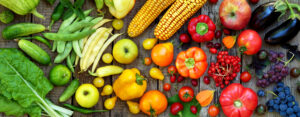Providing healthy food choices for our family can be a daunting task – especially when it comes to feeding our children. And while we want to ensure our kids have adequate nutrients in their meals and snacks, we also want them to love what they’re eating!
In order to accomplish this, it is important to incorporate the recommended servings of fruits and vegetables into our diets daily. This is because fruits and vegetables are great sources of the nutrients our bodies need such as fiber. Fiber aids in digestive health, regulates blood sugar levels, and helps us stay full.
Picky eaters may also be hesitant to try new or unfamiliar foods – notably healthy ones. So understanding what options are available can be very helpful. One great way to encourage kids to eat healthy foods that are full of nutrients is by filling their plates with color! Not only are colorful plates fun to look at, but they are also fun to eat and supply a wide range of nutrients. Focusing on eating colors rather than eating fruits and vegetables is a great way to get kids more excited about the nutrients on their plate.
Fruits and vegetables come in an array of colors that offer different nutritional benefits due to the different plant pigments they contain. In this post, I’ll go through the “nutritional rainbow” and offer examples of each food and their health benefits!
RED FOODS such as red peppers, grapefruit, tomatoes, and watermelon contain a plant pigment called carotenoids. Carotenoids play an important role in plant health and provide protective health benefits to people who eat them, such as enhancing the immune system. These fruits contain an antioxidant called lycopene, which supports heart health! A fun fact is that tomato sauce contains more nutrients than raw tomatoes. This is because adding heat to tomatoes increases the lycopene content!
ORANGE FOODS contain carotenoids (like red foods) and are also rich in beta carotene, a precursor to vitamin A that supports healthy vision, skin, and immune function! Some great sources of beta carotene are sweet potatoes, carrots, butternut squash, cantaloupe, and orange peppers. Orange foods are also high in vitamin C, folate, and potassium. Vitamin C boosts immune health, folate is involved in blood health, and potassium regulates fluid balance and blood pressure.
The last source of carotenoids in our rainbow comes from YELLOW FOODS. Yellow foods include bananas, mangos, yellow peppers, yellow squash, lemons, and pineapple. Just like orange foods, yellow foods are a great source of vitamin C, potassium, and folate. Pineapple contains bromelain, which can be helpful in the reduction of inflammation and swelling.
GREEN FOODS, such as spinach, kale, asparagus, cucumber, green peppers, peas, brussel sprouts, broccoli, and kiwi, all contain a plant pigment called chlorophyll. Chlorophyll is important because it can help boost energy levels and fight off diseases. Leafy greens and broccoli are especially high in vitamin A, vitamin K, magnesium, and calcium. These nutrients are important for maintaining bone and blood health. Spinach and asparagus contain folate, an essential B vitamin for blood health. Avocados are an excellent source of vitamin E which supports immune function as well as nerve and muscle development.
BLUE FOODS and PURPLE FOODS get their beautiful coloring from pigments called flavonoids, specifically betalains and anthocyanins. The most notable source of betalains are beets, while raspberries, blueberries, cherries, blackberries, grapes and eggplant are high in anthocyanins. These plant pigments contain powerful antioxidants and antimicrobials which prevent free radical damage and help the body protect itself against harmful agents that can lead to disease. They can also support healthy vision, blood flow, and neurological health.
Believe it or not, even WHITE FOODS have nutritional benefits! Flavonoids (coloring pigments) called anthoxanthins are found in foods including potatoes, cauliflower, parsnips, cabbage, and onions. This means that these white foods are high in vitamin C, B vitamins, and potassium which makes them an excellent addition to a colorful plate!
SOME FUN AND ENGAGING IDEAS!
- Bring your child grocery shopping with you! They can see all the different colors and pick their favorites. Then you can try making fun recipes with them at home with all the foods that they picked out themselves!
- Prepare a plate with whatever fruits and vegetables you have in your fridge. Arrange the foods in a rainbow and ask your child about the colors they see. Then talk to them about nutrients!
- Beautiful work/desk lunches! Make a pact with your friends to add color to your weekly lunches. Send each other pictures to share fun ideas and stay motivated.
My best,
Arielle

REFERENCES
[1] https://www.sciencedirect.com/science/article/abs/pii/S1043661807000357
[2] https://www.ingentaconnect.com/content/ben/biot/2007/00000001/00000002/art00003
